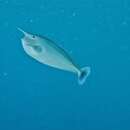en
names in breadcrumbs


The short-nosed unicornfish (Naso brevirostris)[2] is a species of unicornfish in the family Acanthuridae.
Naso brevirostris, commonly referred to as the short-nosed unicornfish, is a marine fish species which belongs to the family Acanthuridae [6]. Naso brevirostris can reach a maximum length of 60 centimetres (24 in).[2] These fishes have an elongate, oval body, with a short snout and a small, protrusible mouth. They are olivaceous brown to bluish grey in color,[2] with a prominent horn, many small dark spots on head and short irregular lines on sides of body. The anterior part of the body is rather pale.[2] The tail is whitish with dark blotch. The caudal knives are relatively larger in males (sexual dimorphism).[3] These fishes have six dorsal spines, 27-29 dorsal soft rays and 27-30 anal soft rays. Subadults show dark spots on head and body, while juveniles lack the prominent horn.[4] Juvenile short-snouted unicornfish may sometimes be slightly different in appearance, being of smaller size and having a smaller bump-like forehead protrusion as opposed to one that appears horn-like [8].
Naso brevirostris is accepted as part of the Acanthuridae family, commonly known as the tangs or surgeonfishes [6]. This family comprises approximately 80 different species of reef fish, the majority of which are herbivorous, which are primarily found in tropical and subtropical waters around the globe [7]. Upon analysis of phylogenetic studies based on mitochondrial DNA markers, it appears the Naso genus is a monophyletic group [2]. This finding indicates that all species within this genus, containing around 20 species of surgeonfish around the Indo-Pacific region, share a common ancestor. Naso brevirostris is found in a clade that also includes species such as Naso caesius, Naso elegans, and Naso hexacanthus; this clade is most closely related to the genus Acanthurus, which includes the commonly recognized blue tang,or Acanthurus coeruleus [6].
It is important to acknowledge the taxonomy based on Linnaean classification when learning about a new taxon. The species Naso brevirostris is classified as part of: the kingdom Animalia, phylum Chordata, class Actinopterygii, order Perciformes, family Acanthuridae, and genus Naso [6].
The scientific name of Naso brevirostris has a long and somewhat confusing history. The naming of this species is often attributed to Pieter Bleeker, a Dutch ichthyologist, who named the species in his 1855 publication translated as ‘Natural History Journal for the Dutch East Indies’ [9]. He originally named the species Acanthurus brevirostris, and was renamed to Naso brevirostris in 1876 when Albert Gunther transferred the species to genus Naso [9]. The genus name, Naso, is Latin for ‘nose’ and brevirostris roughly translates to ‘short snout’ referring to the characteristically short snout present in this species [2]. Recently, there has been a push to reattribute naming and identification rights of this species to George Cuvier, who in 1829 appeared to have described this species under a different name, Nauseous brevirostris [9]. Regardless of the origin, the species is modernly accepted with a scientific name of Naso brevirostris and a common name of short-nosed unicornfish [9].
The origins of the common name, ‘short-nosed unicornfish’, or less commonly ‘spotted unicornfish’, are not as easily determined. It is likely that the name arose as a result of the distinguishing characteristics of this species, specifically the unicorn-like horn projection [8]. This common name is also often used to refer to several other species of fish within the family Acanthuridae, as there are some physical similarities between these species [9].
Naso brevirostris is widespread throughout the Indian and Pacific Oceans.[2][5] Another species, Naso maculatus, may also be called the spotted unicornfish. The Naso brevirostris species is found distributed in the tropical waters of the Indian and Pacific Oceans, ranging from the Red Sea and East Africa to the Hawaiian Islands and French Polynesia [2]. Some short-nosed unicornfish have been recorded in the waters of the Gulf of Aden, the Arabian Sea, and the Bay of Bengal [2]. They are often solitary creatures, but at times can be found in small groups or pairs.
This species is listed as "least concern" on the IUCN Red List of Threatened Species, and there are no observed declines as a result of commercial or recreational fishing.[3]
The short-nosed unicornfish dwells in mid-waters along steep outer lagoon, in rocky shore and seaward reef drop-offs,[2] and prefers water temperatures ranging from 22.4 to 29° Celsius.[4] Naso brevirostris are typically found in habitats such as coral reefs, lagoons, and seaward slopes, often in areas of shallow water with depths of approximately 30 meters and occasionally up to 80 meters [2]. The short-nosed unicornfish will typically feed on benthic algae and other plant sources, as well as occasionally small invertebrates, such as crustaceans and mollusks, and thus frequent locations where those food sources can be found [7]. There are a host of factors which influence the prevalence of Naso brevirostris including: water temperature, salinity, and the availability of suitable habitat and food resources [2]. In some regions, overfishing has begun to lead to a decline in population numbers.
This species forms spawning aggregations.[3] Adults feed on algae and zooplankton, while juveniles mainly feed on benthic algae.[4]
Spotted unicornfish at the Toledo Zoo
At the Schönbrunn Zoo
[5] Naso brevirostris (Cuvier, 1829). IRMNG. (2022). Retrieved April 19, 2023, from https://www.irmng.org/aphia.php?p=taxdetails&id=10716480 [6] Species: Naso brevirostris, spotted unicornfish. Shorefishes - The Fishes - Species. (n.d.). Retrieved April 19, 2023, from https://biogeodb.stri.si.edu/sftep/en/thefishes/species/2507 [7] U.S. National Library of Medicine. (n.d.). Taxonomy browser (Naso brevirostris). National Center for Biotechnology Information. Retrieved April 19, 2023, from https://www.ncbi.nlm.nih.gov/Taxonomy/Browser/wwwtax.cgi?id=238055 [8] WoRMS taxon details Naso brevirostris (Cuvier, 1829). Worms - world register of marine species - naso brevirostris (Cuvier, 1829). (n.d.). Retrieved April 19, 2023, from https://www.marinespecies.org/aphia.php?p=taxdetails&id=219671#sources
The short-nosed unicornfish (Naso brevirostris) is a species of unicornfish in the family Acanthuridae.